The weaponization of Waymo
How protestors turned torched Waymos into icons of the anti-ICE demonstrations
The incinerated husks of Waymo cars were lined up neatly in a row downtown, on Los Angeles Street; one, two, three, four, five of them. And I do mean incinerated. I’ve never seen cars torched so thoroughly. There were sedan-sized piles of ash where Jaguar I-Paces outfitted with lidar sensors used to be, recognizable as cars at all only by wheel frames and blackened chassis. They smelled awful.
The day before, Sunday, June 9th, Trump brought in the national guard to shoot rubber bullets and tear gas at people protesting ICE raids, and the blazing, graffiti’d Waymos quickly became an icon of the conflict. Images of masked demonstrators standing atop the roof of the smoldering vehicles went viral, circulated by news outlets and shared unapprovingly by Elon Musk. You have probably seen many of them at this point.
A quick message: BLOOD IN THE MACHINE is 100% reader-supported and made possible by my incomparable paying subscribers. I’m able to keep the vast majority of my work free to read and open to all thanks to that support. If you can, for the cost of a coffee a month, or, say, an LA taxi ride a year, consider helping me keep this thing running. Thanks everyone. Onwards.
That one in particular, is blunt and memorable—man conquering machine and all that.
Google suspended Waymo service to downtown LA, and also in San Francisco, where solidarity protests unfolded. “Why the self-driving cars were targeted remains unknown” is a refrain I heard multiple times on TV and radio news. The reason does not seem so secret to a lot of people.
“Oh they called them up on purpose, lit ‘em on fire like that,” a cameraman shooting on the scene the next day told me. The charred husks in a neat line do seem to suggest that was the case. Other witnesses and journalists who were there shared the same story: People summoned the cars to light them on fire when they arrived. Protestors were reportedly calling them “spy cars” as they were vandalized and set ablaze, and some noted how the cars can share data with the LAPD.
As a result, there’s been some speculation that the cars were burned to destroy evidence. There’s likely more to it than that—and that the cars weren’t torched to destroy evidence as much to punish collaborators.
It’s true, after all, that Waymos are roving surveillance machines. 404 Media has reported that the LAPD, as well as other police departments across the country, have obtained surveillance footage from Waymo vehicles and used it as evidence. Google, for its part, confirmed that it hands over this data upon request, usually, it says, through court order, warrant, or subpoena.
No one I spoke to would cop to having anything to do with actually burning the cars, much less discuss the reason the headline-grabbing tactic was deployed. But it might be noted that ICE raids are carried out using data provided by Silicon Valley companies—most notably Peter Thiel and Alex Karp’s Palantir, which has a $30 million contract with ICE to manage a “real-time” surveillance system on immigrants. But whether directly or through third party contractors, much of big tech, including Google, has made deals with ICE, too.
Who knows whether that played a role in ICE protestors’ coordinating a pyrotechnic display on Sunday, whether it was a spontaneous idea to make a memorable visual provocation, or just part of the pure chaos unfolding that day. But as I’ve argued in this newsletter before, in light of previous epidemics of self-driving car trashings and torchings, such actions are liable to spring from the growing reservoir of public anger towards a Silicon Valley that has grown unaccountable and extractive—and has now largely aligned itself with a punitive state.
Torching the Google car: Why the growing revolt against big tech just escalated
We don’t yet know exactly why a group of people very publicly graffitied, smashed, and torched a Waymo car in San Francisco. But we know enough to understand that this is an explosive milestone in the growing, if scattershot, revolt against big tech.
Now, given Silicon Valley’s more obvious alliance with the Trump administration, that ambient anger has only been sharpened. It has sparked backlashes of a different kind, like the protests and firebombing of Teslas and Tesla dealerships. Waymos occupy part of this same nexus; surveillance technology operated by a tech giant, undemocratically, opaquely, led by a CEO that visits Mar-a-Lago and donates to Trump. The New York Times spoke to a protestor in San Francisco yesterday who underlined this point:
The robot taxis have become a way for some protesters to display resistance to the tech industry’s close ties to the Trump administration, said Elise Joshi, an activist in San Francisco who attended rallies on Monday.
“Waymos don’t have human drivers, they’re devoid of humanity,” she said. Destroyed robot taxis are “symbolic of the attempts, throughout the history of this country, by the tech industry to strip us of community.”
Burning them down in broad daylight makes for quite a statement. Now there are just the husks left. But it wasn’t just Waymo cars that were targeted, though. Lime scooters were hurled down at police cars from an overpass and heaped onto the Waymo pyres, too.
I saw them wedged in bushes, broken into pieces on the side of the street, or toppled on the sidewalk next to a contingent of riot gear-clad police.
One thing that I was thinking about as I walked around downtown, the somewhat gloomy summer fog helping to hold the fumes and the apocalyptic mood from last nights’ violence in the air, multiple helicopters and an airborne drone circling, was the way that protestors had turned the self-driving cars against the state they were designed to appease.
Waymos are ultimately an automation technology product. And a key function of any kind of automation is that it serves as an accountability sink for the companies and managers that deploy it. Self-driving cars, AI, app-unlocked e-scooters—tech companies like this stuff because it promises not just to remove labor from the equation, but accountability. There is no driver to blame if something goes wrong with the self-driving car, it’s a glitchy algorithm; or better yet, it was probably somebody else’s fault because Google’s algorithm is safe and sophisticated, even if it won’t tell you how that algorithm actually works. Trade secret, sorry. Decision-making and responsibility is masked behind obscured algorithmic systems, available to the company and the state, but not to us. Meanwhile there is also no one visible who is responsible for maintaining and organizing the e-scooters; the app will teach you where to put the scooter or entice you to charge it for a buck.
These are technologies that are at best agnostic to the communities and environments they operate in, and more often are extractive. The Waymo contributes to congestion, surveils neighborhoods, replaces the Uber or cab driver, and sends any resultant future profits upstream to a tech company in Mountain View. The scooters jam up walkways, become e-waste, and scramble local traffic patterns. But it’s hard to blame robots for any of that, and get it to stick.
Yet the ICE protestors who torched the Waymo cars and hurled Lime scooters onto the flames, are turning what the tech companies see as an asset into a vulnerability, and they’re exploiting it. There is no one around to stop them from hailing a Waymo car and destroying it, and no one to intervene in the untimely demise of the Lime scooter. They have turned these indifferent and extractive technologies into instruments of protest. They are weaponizing the accountability sink.
I walked up the hill to Grand Park by city hall, where the SEIU was holding a rally in support of David Huerta, the labor leader who had been arrested by ICE over the weekend and charged with felony counts of obstructing an immigration officer—he allegedly sat down and blocked an entrance as ICE agents were aiming to round up undocumented workers. I passed the national guard and their vests full of less lethal ammo, and rows of police SUVs with the lights flashing on.
The drone hung in the sky, the helicopters circled, and I wondered if that was no longer burnt lithium I was smelling but the residue of tear gas. The band played Stand by Me, and some people sung along. There were no Waymos in sight, as far as I could see from my vantage point at the top—the ban still held.
That’s all for today. Cut me some slack if there are typos etc, wrote this up in a hurry/state of exhaustion.
I’m headed to New York this week to participate in a panel discussion for the Tribeca premiere of an Audible series I’m in—What Could Go Wrong? by Contagion screenwriter Scott Z Burn. I’ll be talking about AI, labor, and the luddites, as per usual. Come say hello if you’re around.
[I PROMISE the AI Killed My Job story is forthcoming, but, well, there was an uprising in my city over the weekend and that took precedence.]
Until next time—hammers up.
bcm



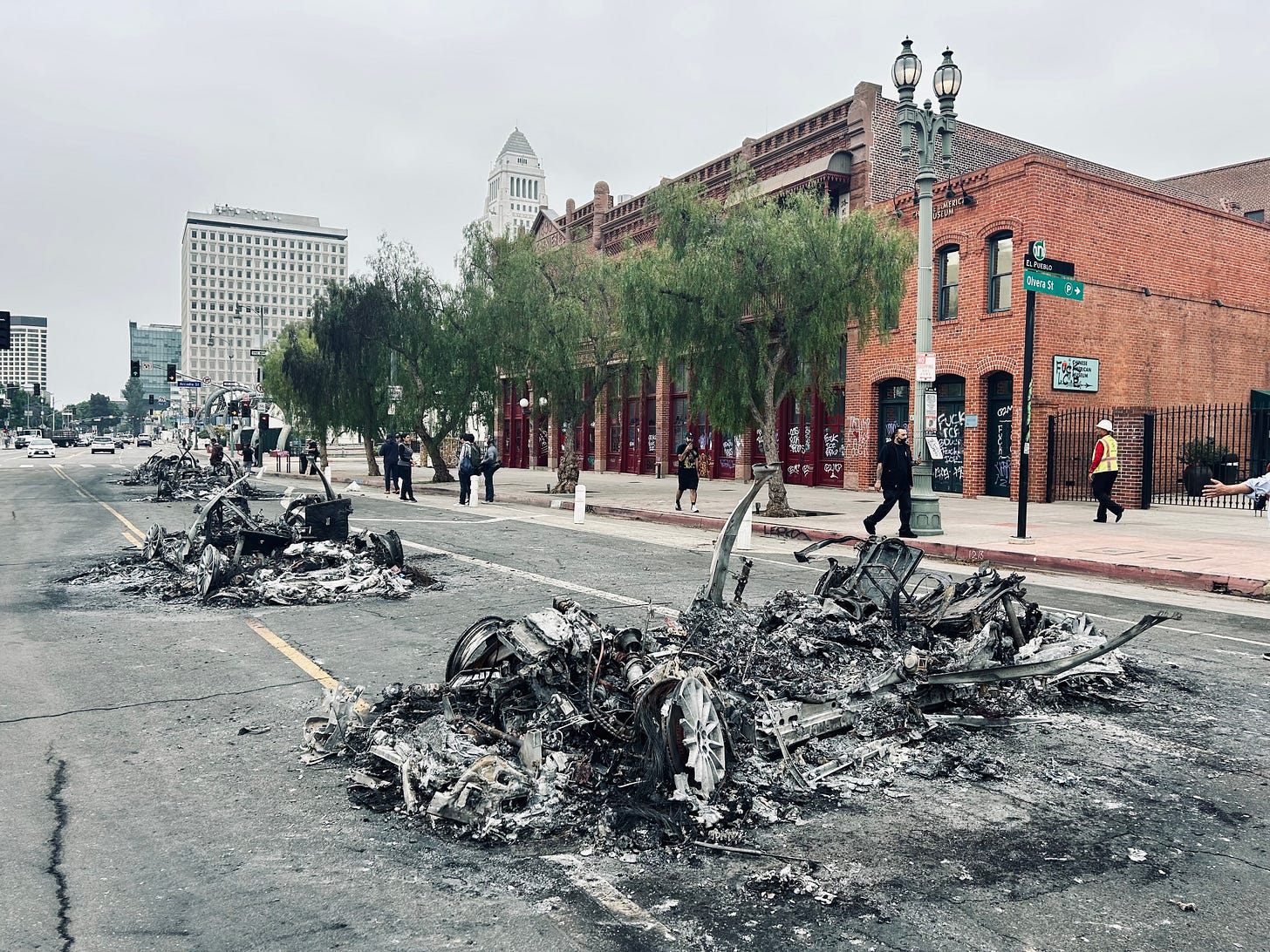
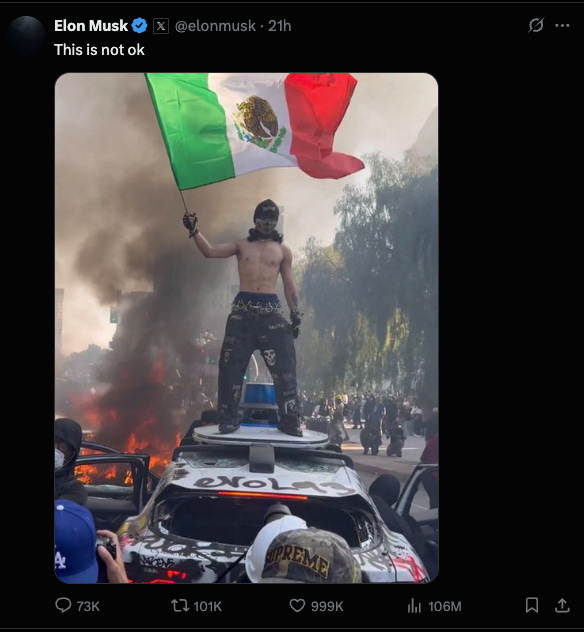
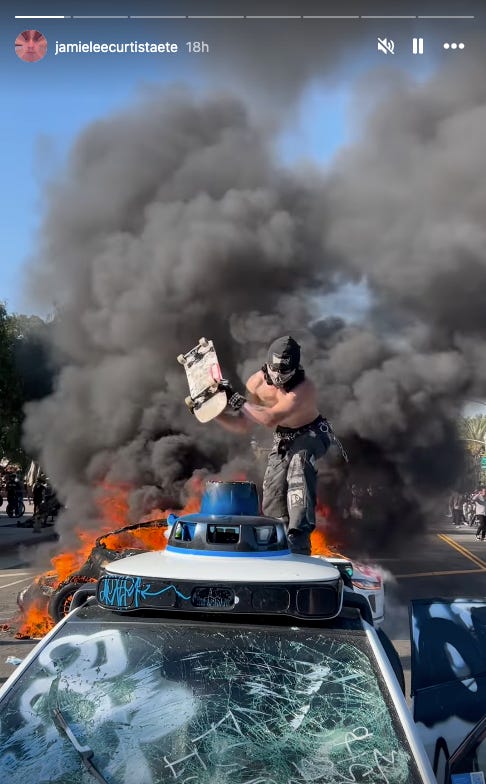
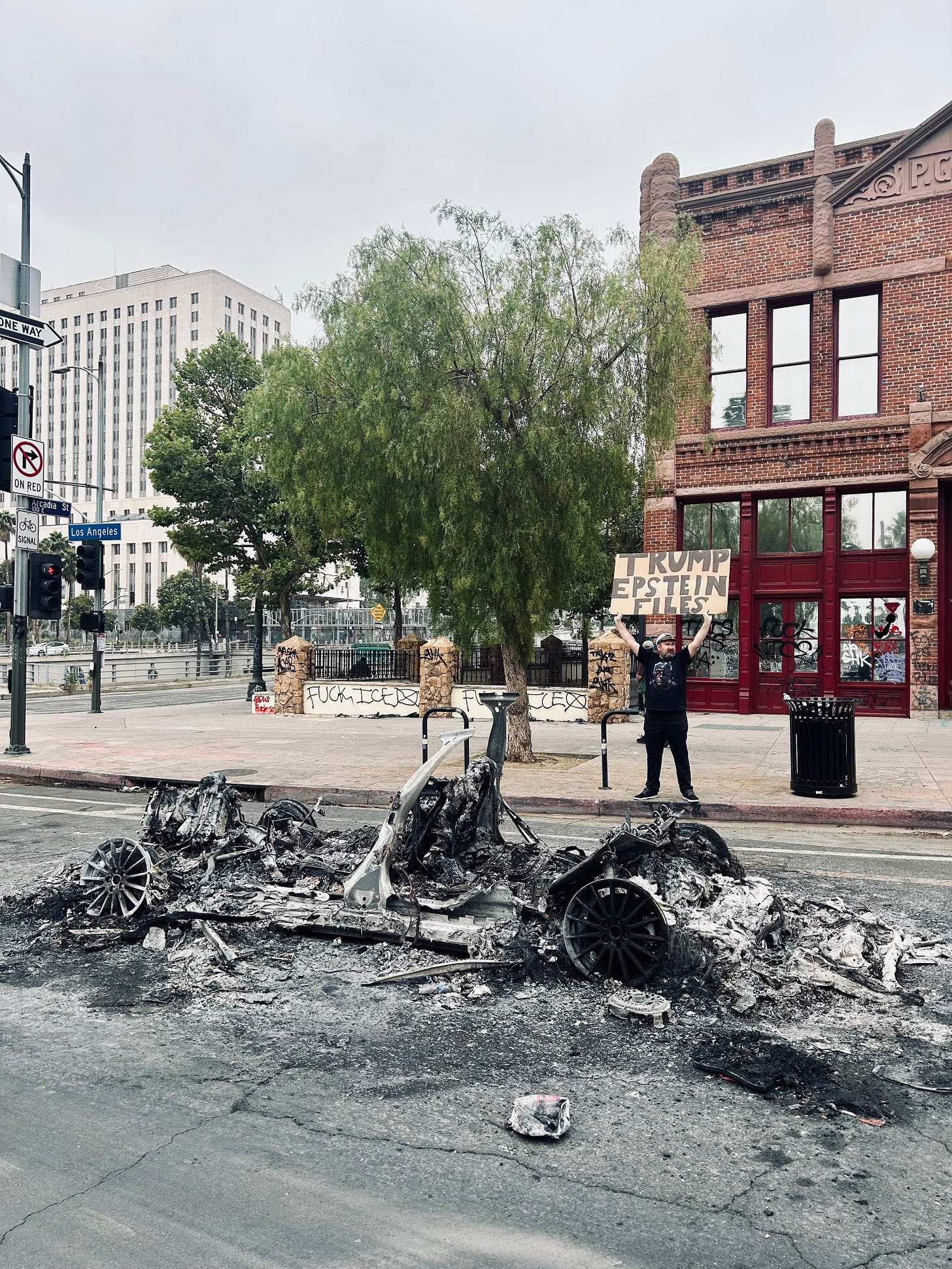

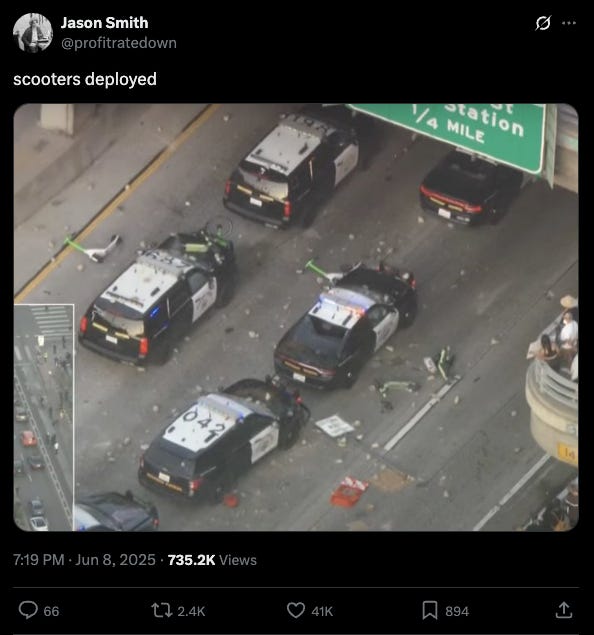
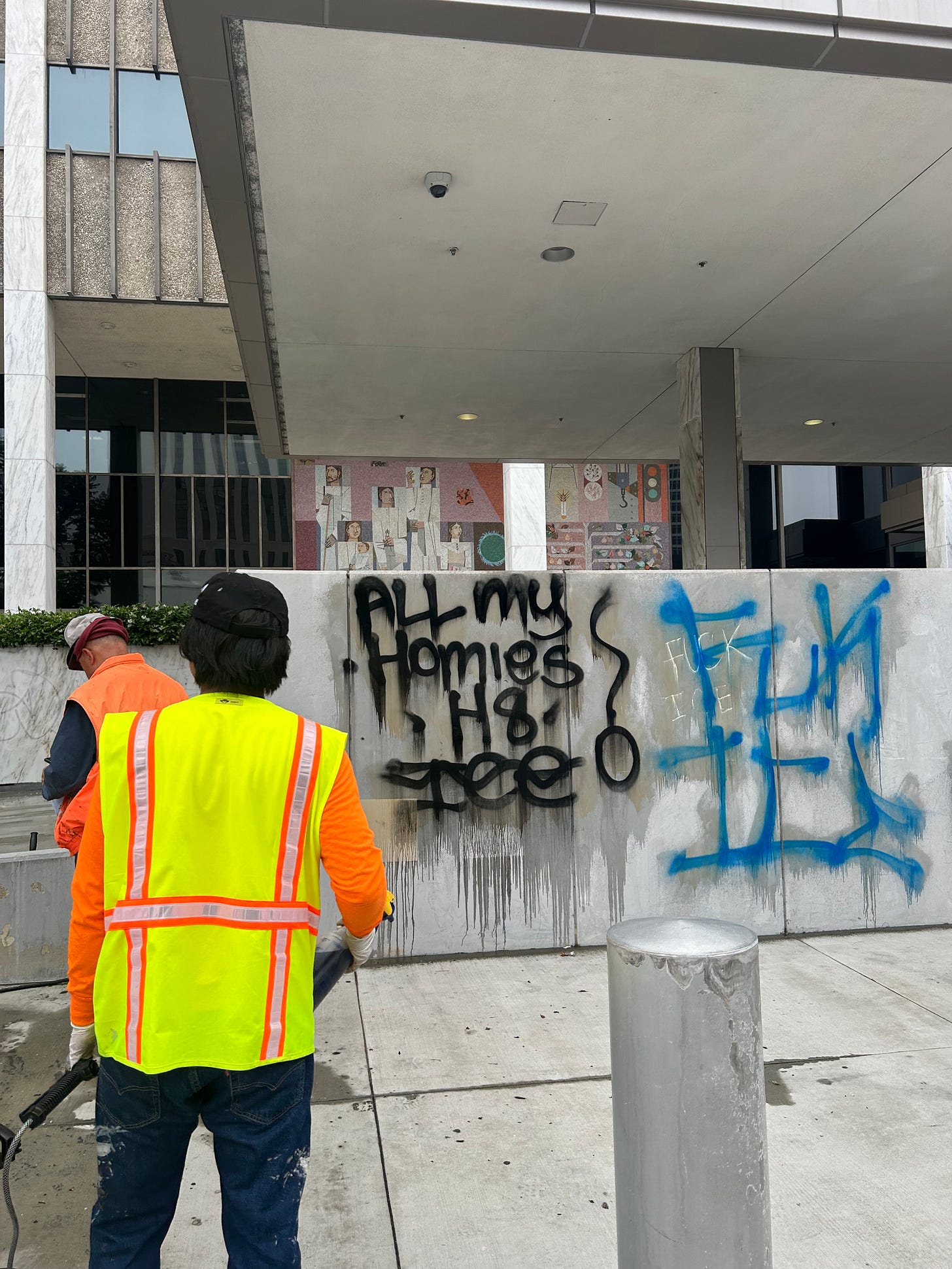
“Waymos don’t have human drivers, they’re devoid of humanity,” she said. Destroyed robot taxis are “symbolic of the attempts, throughout the history of this country, by the tech industry to strip us of community.”
That last bit is pretty succinct - the tech industry is absolutely stripping us of community. Modern generations don't know life without Big Tech, but we gen-Xers remember life before the algorithm, and it was beautiful and hopeful.
Thank you for this on-the-scene report--I didn't know these things had happened. Perhaps a result of not reading mainstream press--THERE they probably emphasized this " violence," which will be used as an excuse for the lockdown coming, likely not just of LA but every city with a No Kings protest, which is all of them. I will be in Charleston, West Virginia.